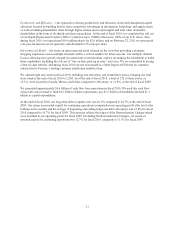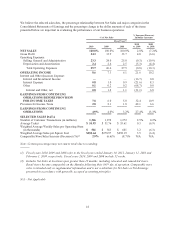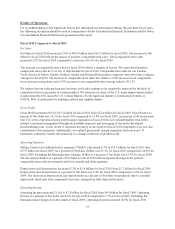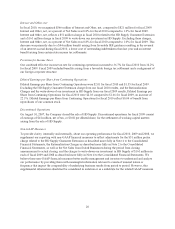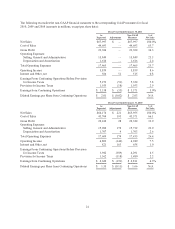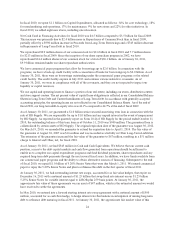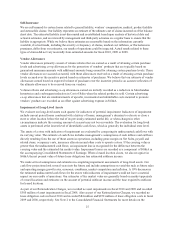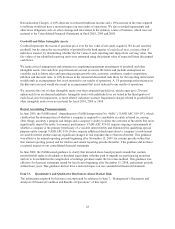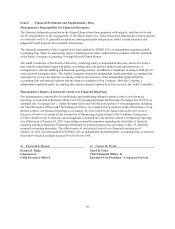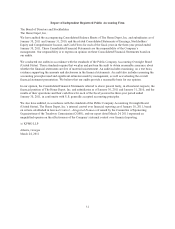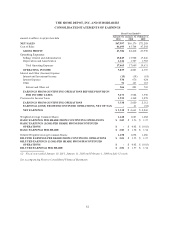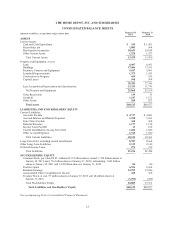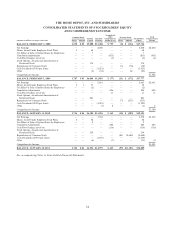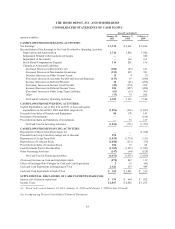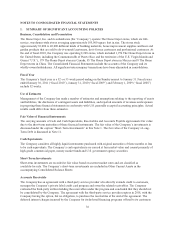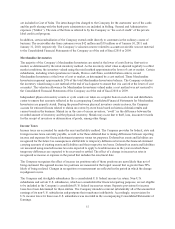Home Depot 2010 Annual Report Download - page 33
Download and view the complete annual report
Please find page 33 of the 2010 Home Depot annual report below. You can navigate through the pages in the report by either clicking on the pages listed below, or by using the keyword search tool below to find specific information within the annual report.Self-Insurance
We are self-insured for certain losses related to general liability, workers’ compensation, medical, product liability
and automobile claims. Our liability represents an estimate of the ultimate cost of claims incurred as of the balance
sheet date. The estimated liability is not discounted and is established based upon analysis of historical data and
actuarial estimates, and is reviewed by management and third-party actuaries on a regular basis to ensure that the
liability is appropriate. While we believe these estimates are reasonable based on the information currently
available, if actual trends, including the severity or frequency of claims, medical cost inflation, or fluctuations in
premiums, differ from our estimates, our results of operations could be impacted. Actual results related to these
types of claims did not vary materially from estimated amounts for fiscal 2010, 2009 or 2008.
Vendor Allowances
Vendor allowances primarily consist of volume rebates that are earned as a result of attaining certain purchase
levels and advertising co-op allowances for the promotion of vendors’ products that are typically based on
guaranteed minimum amounts with additional amounts being earned for attaining certain purchase levels. These
vendor allowances are accrued as earned, with those allowances received as a result of attaining certain purchase
levels accrued over the incentive period based on estimates of purchases. We believe that our estimate of vendor
allowances earned based on expected volume of purchases over the incentive period is an accurate reflection of
the ultimate allowance to be received from our vendors.
Volume rebates and advertising co-op allowances earned are initially recorded as a reduction in Merchandise
Inventories and a subsequent reduction in Cost of Sales when the related product is sold. Certain advertising
co-op allowances that are reimbursements of specific, incremental and identifiable costs incurred to promote
vendors’ products are recorded as an offset against advertising expense in SG&A.
Impairment of Long-Lived Assets
We evaluate our long-lived assets each quarter for indicators of potential impairment. Indicators of impairment
include current period losses combined with a history of losses, management’s decision to relocate or close a
store or other location before the end of its previously estimated useful life, or when changes in other
circumstances indicate the carrying amount of an asset may not be recoverable. The evaluation for long-lived
assets is performed at the lowest level of identifiable cash flows, which is generally the individual store level.
The assets of a store with indicators of impairment are evaluated by comparing its undiscounted cash flows with
its carrying value. The estimate of cash flows includes management’s assumptions of cash inflows and outflows
directly resulting from the use of those assets in operations, including gross margin on Net Sales, payroll and
related items, occupancy costs, insurance allocations and other costs to operate a store. If the carrying value is
greater than the undiscounted cash flows, an impairment loss is recognized for the difference between the
carrying value and the estimated fair market value. Impairment losses are recorded as a component of SG&A in
the accompanying Consolidated Statements of Earnings. When a leased location closes, we also recognize in
SG&A the net present value of future lease obligations less estimated sublease income.
We make critical assumptions and estimates in completing impairment assessments of long-lived assets. Our
cash flow projections look several years into the future and include assumptions on variables such as future sales
and operating margin growth rates, economic conditions, market competition and inflation. A 10% decrease in
the estimated undiscounted cash flows for the stores with indicators of impairment would not have a material
impact on our results of operations. Our estimates of fair market value are generally based on market appraisals
of owned locations and estimates on the amount of potential sublease income and the time required to sublease
for leased locations.
As part of our Rationalization Charges, we recorded no asset impairments in fiscal 2010 and 2009 and recorded
$580 million of asset impairments in fiscal 2008. Also as part of our Rationalization Charges, we recorded no
lease obligation costs in fiscal 2010 and recorded $84 million and $252 million of lease obligation costs in fiscal
2009 and 2008, respectively. See Note 2 to the Consolidated Financial Statements for more details on the
27


